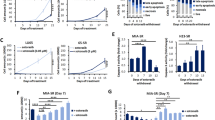Abstract
Oncogenic KRAS reprograms pancreatic ductal adenocarcinoma (PDAC) cells to a state that is awfully resistant to apoptosis. An alternative coping strategy is to trigger a nonapoptotic cell death. Herein, a multi specific platinum complex SEP was constructed by conjugating a quinone derivative seratrodast to a prodrug of cisplatin. Interestingly, SEP-treated KRAS-mutant PDAC cells showed the characteristics of pyroptosis, apoptosis and necroptosis, similar to PANoptosis (a newfound inflammatory cell death). Mechanistically, SEP could enter cancer cells effectively, then damage nuclear DNA, boost mitochondrial superoxide anion radicals and affect various signaling pathways related to redox homeostasis and tumor metabolism. To our best knowledge, SEP is the first metal complex, even small molecule, to elicit PANoptosis (pyroptosis, apoptosis and necroptosis) in cancer cells, providing a new strategy to overcome apoptotic resistance of KRAS-mutant PDAC.

Similar content being viewed by others
References
Bear AS, Vonderheide RH, O’Hara MH. Cancer Cell, 2020, 38: 788–802
Zheng X, Carstens JL, Kim J, Scheible M, Kaye J, Sugimoto H, Wu CC, LeBleu VS, Kalluri R. Nature, 2015, 527: 525–530
Hidalgo M. N Engl J Med, 2010, 362: 1605–1617
Wang D, Lippard SJ. Nat Rev Drug Discov, 2005, 4: 307–320
Boros E, Dyson PJ, Gasser G. Chem, 2020, 6: 41–60
Carneiro BA, El-Deiry WS. Nat Rev Clin Oncol, 2020, 17: 395–417
Xiong K, Qian C, Yuan Y, Wei L, Liao X, He L, Rees TW, Chen Y, Wan J, Ji L, Chao H. Angew Chem Int Ed, 2020, 59: 16631–16637
Suntharalingam K, Awuah SG, Bruno PM, Johnstone TC, Wang F, Lin W, Zheng YR, Page JE, Hemann MT, Lippard SJ. J Am Chem Soc, 2015, 137: 2967–2974
Wong DYQ, Lim JH, Ang WH. Chem Sci, 2015, 6: 3051–3056
Wang WJ, Ling YY, Zhong YM, et al. Angew Chem Int Ed, 2021, 133: e202115247
Cao Q, Zhou DJ, Pan ZY, Yang GG, Zhang H, Ji LN, Mao ZW. Angew Chem Int Ed, 2020, 59: 18556–18562
Malireddi RKSK, Sannula, Kanneganti, et al. Front Cell Infect Microbiol, 2019, 9: 406
Lee SJ, Karki R, Wang Y, Nguyen LN, Kalathur RC, Kanneganti TD. Nature, 2021, 597: 415–419
Hayes JD, Dinkova-Kostova AT, Tew KD. Cancer Cell, 2020, 38: 167–197
Dharmaraja AT. J Med Chem, 2017, 60: 3221–3240
Bolton JL, Dunlap T. Chem Res Toxicol, 2017, 30: 13–37
Wang Y, Shi P, Chen Q, Huang Z, Zou D, Zhang J, Gao X, Lin Z. J Mol Cell Biol, 2019, 11: 1069–1082
Deng Z, Wang N, Liu Y, Xu Z, Wang Z, Lau TC, Zhu G. J Am Chem Soc, 2020, 142: 7803–7812
Gibson D. J Inorg Biochem, 2019, 191: 77–84
Kuang Y, Sechi M, Nurra S, Ljungman M, Neamati N. J Med Chem, 2018, 61: 1576–1594
Revet I, Feeney L, Bruguera S, Wilson W, Dong TK, Oh DH, Dankort D, Cleaver JE. Proc Natl Acad Sci USA, 2011, 108: 8663–8667
Zheng YR, Suntharalingam K, Johnstone TC, Yoo H, Lin W, Brooks JG, Lippard SJ. J Am Chem Soc, 2014, 136: 8790–8798
Wang WJ, Chen D, Jiang MZ, Xu B, Li XW, Chu Y, Zhang YJ, Mao R, Liang J, Fan DM. J Digest Dis, 2018, 19: 74–83
Quail DF, Joyce JA. Nat Med, 2013, 19: 1423–1437
Ouyang C, Chen L, Rees TW, Chen Y, Liu J, Ji L, Long J, Chao H. Chem Commun, 2018, 54: 6268–6271
Denecker G, Dooms H, Van Loo G, Vercammen D, Grooten J, Fiers W, Declercq W, Vandenabeele P. FEBS Lett, 2000, 465: 47–52
Zhang DW, Shao J, Lin J, Zhang N, Lu BJ, Lin SC, Dong MQ, Han J. Science, 2009, 325: 332–336
Dong N, Shao F. Sci Sin-Vitae, 2019, 49: 1606–1634
Lamkanfi M, Dixit VM. Cell, 2014, 157: 1013–1022
Shi J, Zhao Y, Wang K, Shi X, Wang Y, Huang H, Zhuang Y, Cai T, Wang F, Shao F. Nature, 2015, 526: 660–665
Yu J, Li S, Qi J, Chen Z, Wu Y, Guo J, Wang K, Sun X, Zheng J. Cell Death Dis, 2019, 10: 193
Liu X, Zhang Z, Ruan J, Pan Y, Magupalli VG, Wu H, Lieberman J. Nature, 2016, 535: 153–158
Wang Y, Gao W, Shi X, Ding J, Liu W, He H, Wang K, Shao F. Nature, 2017, 547: 99–103
Malireddi RKS, Karki R, Sundaram B, Kancharana B, Lee SJ, Samir P, Kanneganti TD. ImmunoHorizons, 2021, 5: 568–580
Acknowledgements
This work was supported by the National Natural Science Foundation of China (21731004, 91953201, 21907050, 22107047), the Natural Science Foundation of Jiangsu Province (BK20202004), the Postdoctoral Research Funding Program of Jiangsu Province (003503) and the Excellent Research Program of Nanjing University (ZYJH004).
Author information
Authors and Affiliations
Corresponding authors
Ethics declarations
Conflict of interest The authors declare no conflict of interest.
Additional information
Supporting information The supporting information is available online at https://chem.scichina.com and https://link.springer.com/journal/11426. The supporting materials are published as submitted, without typesetting or editing. The responsibility for scientific accuracy and content remains entirely with the authors.
Rights and permissions
About this article
Cite this article
Yuan, X., Zhang, S., Zhong, X. et al. The induction of PANoptosis in KRAS-mutant pancreatic ductal adenocarcinoma cells by a multispecific platinum complex. Sci. China Chem. 65, 1978–1984 (2022). https://doi.org/10.1007/s11426-022-1314-3
Received:
Accepted:
Published:
Issue Date:
DOI: https://doi.org/10.1007/s11426-022-1314-3




